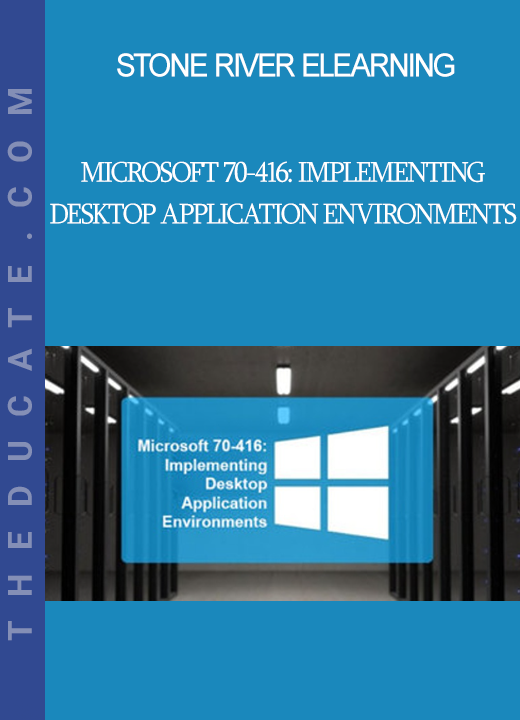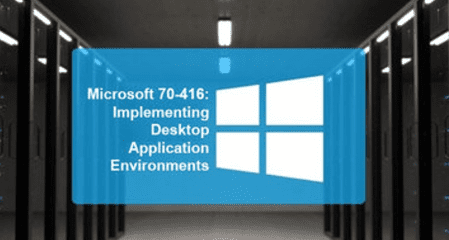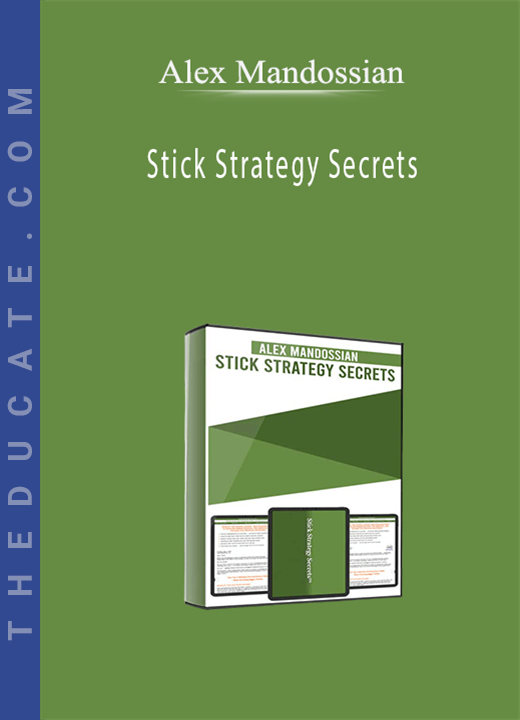Description
Stone River Elearning – Microsoft 70-416: Implementing Desktop Application Environments
The Implementing Desktop Application Environments course provides IT professionals with the opportunity to validate their skills and knowledge necessary to design, implement, and support a Windows Server 2012 desktop infrastructure in an enterprise scaled, extremely virtualized setting. This course provides credit towards the MCSE certification.
This course is intended for IT professionals and is part two of two exams which validate the student’s aptitude to plan, configure, and implement Windows Server 2012 desktop services, as well as confirms the skills and knowledge necessary for designing, deploying, and maintaining desktop infrastructure services in Windows Server 2012 settings.
Some of the skills you will learn in this class are:
- Designing and preparing the application environment
- Planning and implementing app compatibility
- Updating apps in desktop images
- Planning and implementing presentation virtualization servers
- Creating, configuring, deploying, and managing remote applications
- Installing and configuring application virtualization environments
- Preparing virtual applications
- Managing application virtualization environments
- Deploying applications to the desktop
- Planning and implementing application updates and upgrades
- Implementing applications security
- Monitoring applications
- Designing and implementing a resilient Remote Desktop infrastructure
- Designing and implementing business continuity for virtual desktops
- Designing and implementing a resilient virtual application delivery infrastructure
Course Curriculum
- Implementing Desktop Application Environments (2:41)
- Instructor Introduction (1:55)
- Course Objectives (1:08)
- Course Overview (3:07)
- Audience Profiles (2:14)
- Prerequisites (2:11)
- Domainwise (1:33)
- Certification Overview (1:06)
- Microsoft Website Part1 (4:31)
- Microsoft Website Part2 (3:52)
- Chapter Review (0:41)
- Windows Desktop Application (5:06)
- Lab Setup (2:42)
- Presentation Layout (1:57)
- Servers and Client (2:59)
- Distribution Strategies (0:43)
- Overview (2:03)
- Applications are Everything Part1 (3:13)
- Applications are Everything Part2 (5:25)
- Basic Network Part1 (6:42)
- Basic Network Part2 (1:46)
- Deployment and Operations Infrastructure (5:39)
- Planned Server Topology (7:01)
- VOIP Infrastructure (1:55)
- Network Topology (4:41)
- User Office (1:52)
- Distribution Strategy (4:33)
- Designing an Application Distribution Strategy (0:29)
- Chapter Review (1:53)
- Presentation vs. App-V (0:48)
- Overview (2:27)
- Thin Client (2:23)
- Application Virtualization (App-V) (4:07)
- Virtualization Basics (6:01)
- App-V Desktop (4:53)
- MAP Toolkit Part1 (5:59)
- MAP Toolkit Part2 (8:28)
- Chapter Review (1:55)
- Designing Upgrade/Update Scenarios (1:01)
- Application Total Cost of Ownership (TCO) (4:39)
- Update/Upgrade Part1 (5:59)
- Update/Upgrade Part2 (5:37)
- Configure WSUS Windows Server Update Services (8:24)
- Upgrade Considerations (4:21)
- Supersedence Part1 (5:25)
- Supersedence Part2 (3:44)
- Chapter Review (0:50)
- Application Compatibility (4:08)
- Issues (4:31)
- OS Migration (3:49)
- Permissions (2:33)
- Windows Tools (2:53)
- ACT 6.0 (5:37)
- Hyper-V and App-V (3:18)
- RDS and SHIM (3:12)
- Application Compatibility Toolkit (ACT) Part1 (8:45)
- Application Compatibility Toolkit (ACT) Part2 (7:18)
- Application Compatibility Toolkit (ACT) Part3 (7:19)
- Application Compatibility Toolkit (ACT) Part4 (7:17)
- Chapter Review (1:32)
- Deploy with Group Policy Objects (GPO) (0:55)
- GPO Deployment (2:37)
- Example (2:01)
- Target (1:31)
- Distribution (1:38)
- Assign and Publish (1:57)
- Pros vs. Cons (1:18)
- Application Deployment with Group Policy Part1 (6:14)
- Application Deployment with Group Policy Part2 (7:09)
- Application Deployment with Group Policy Part3 (6:38)
- Chapter Review (0:48)
- Deploy with Intune (1:04)
- Intune Deployment (2:31)
- Intune Client (1:59)
- Grouping (1:29)
- Software (1:28)
- Deployment (1:04)
- Intune Demo Part1 (6:42)
- Intune Demo Part2 (7:27)
- Intune Demo Part3 (1:33)
- Intune Demo Part4 (8:44)
- Intune Demo Part5 (2:53)
- Chapter Review (1:04)
- Deploy with SCCM 2012 (2:06)
- System Center Configuration Manager (SCCM) (1:29)
- Collections (2:56)
- Software Deployment (1:34)
- Asset Intelligence (2:08)
- Software Application (2:47)
- App vs. Package (2:23)
- Distribution (3:11)
- SCCM Demo Part1 (9:28)
- SCCM Demo Part2 (9:39)
- SCCM Demo Part3 (9:48)
- SCCM Demo Part4 (3:54)
- Chapter Review (0:28)
- Self-Service Deployment (1:06)
- Self-Service Basics (5:36)
- Self-Service Benefits (3:12)
- Usage (2:35)
- Intune (2:04)
- Self-Service with SCCM 2012 (4:56)
- Service Manger 2012 (2:04)
- Self Service User Portal Part1 (7:53)
- Self Service User Portal Part2 (5:10)
- Self Service User Portal Part3 (7:23)
- Self Service User Portal Part4 (6:46)
- Self Service User Portal Part5 (8:07)
- Chapter Review (1:04)
- Presentation Infrastructure (2:03)
- Overview (3:39)
- Presentation Virtualization (3:01)
- Usage Consideration (3:42)
- Network (1:37)
- RD Session Host (6:23)
- Remote Desktop (RD) Gateway (5:37)
- Farm (2:31)
- Creating a Presentation Infrastructure Part1 (5:07)
- Creating a Presentation Infrastructure Part2 (9:08)
- Chapter Review (1:25)
- Presentation Configuration (0:57)
- Presentation Types (4:14)
- Methods (5:29)
- Session Collection (1:54)
- Publish App (3:59)
- Remote Desktop Services (RDS) Deployment Part1 (8:36)
- Remote Desktop Services (RDS) Deployment Part2 (6:34)
- Remote Desktop Services (RDS) Deployment Part3 (9:51)
- Remote Desktop Services (RDS) Deployment Part4 (7:27)
- Chapter Review (1:31)
- App-V Infrastructure (1:30)
- App-V Overview (0:37)
- Basic App-V 5.0 (2:19)
- Publishing Server (1:28)
- Management Server and DB (2:41)
- Management Console (0:12)
- Management Database (0:47)
- Reporting Server DB (0:53)
- Sequencer (1:34)
- Client App-V (1:50)
- Client App-V (1:48)
- Preparing for App-V Development Part1 (9:51)
- Preparing for App-V Development Part2 (4:53)
- Preparing for App-V Development Part3 (9:46)
- Preparing for App-V Development Part4 (7:38)
- Chapter Review (2:33)
- App-V Sequencing and Deployment (1:36)
- Sequencer (5:04)
- Sequencer Steps (5:05)
- Deploy App (1:29)
- Online vs. Offline (2:16)
- App-V Sequencer Part1 (9:40)
- App-V Sequencer Part2 (8:54)
- App-V Sequencer Part3 (8:40)
- App-V Sequencer Part4 (9:53)
- Chapter Review (1:26)
- Application Security (1:40)
- Security 101 (3:05)
- AppLocker (2:06)
- Endpoint Protection (FEP) Part1 (0:41)
- Endpoint Protection (FEP) Part2 (3:39)
- Policies (1:39)
- Intune (2:01)
- Data Execution Prevention (DEP) (1:14)
- User Account Control (UAC) (2:25)
- AppLocker Demo (8:55)
- Chapter Review (0:52)
- Application Updates (0:54)
- Updating Applications Part1 (3:53)
- Updating Applications Part2 (3:32)
- Evaluating Updates (4:44)
- Testing Updates (4:16)
- Test and Deploy (5:48)
- Deploying an Application Update using SCCM Part1 (6:08)
- Deploying an Application Update using SCCM Part2 (7:33)
- Chapter Review (0:38)
- Upgrade and Supersedence (0:51)
- Upgrade Basics (5:20)
- Upgrade Considerations (3:07)
- Upgrade Specifics Part1 (4:18)
- Upgrade Specifics Part2 (3:17)
- SCCM 2012 Part1 (3:34)
- SCCM 2012 Part2 (5:12)
- SCCM 2012 Part3 (0:41)
- SCCM Library Part1 (3:06)
- SCCM Library Part2 (6:47)
- SCCM Library Part3 (3:38)
- SCCM Library Part4 (2:42)
- Chapter Review (0:45)
- Monitoring Deployment (2:37)
- Monitoring Basics (3:37)
- Business Needs (4:06)
- IT Operations (4:54)
- Server (1:17)
- Operations Manager (3:06)
- Asset Intelligence & System Center Operations Manager (SCOM) Part1 (7:07)
- Asset Intelligence & System Center Operations Manager (SCOM) Part2 (7:19)
- Asset Intelligence & System Center Operations Manager (SCOM) Part3 (5:18)
- Chapter Review (1:19)
- Certification and Review (4:46)
- Certification Overview (5:40)
- Microsoft Blogs and Forum (2:42)
Sale Page: https://stoneriverelearning.com/p/microsoft-70-416
Archive: https://archive.ph/wip/lSJMm







Reviews
There are no reviews yet.